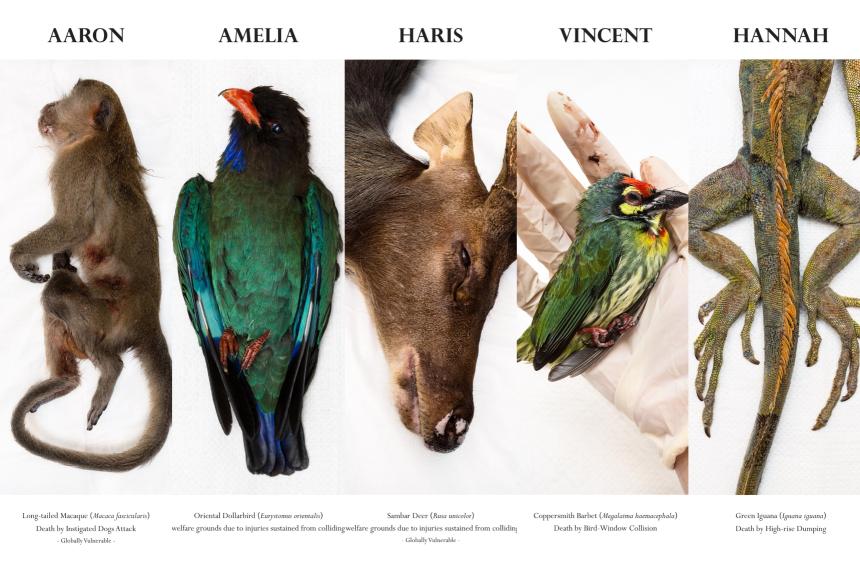SINGAPORE – Amid Singapore’s urban sprawl, animals like otters, macaques and monitor lizards have taken up residence. But with increasing development, it has become more challenging for people to coexist peacefully with wildlife.
Ahead of Halloween, the Death By Man photography exhibition showcases the morbid consequences of human activity and rapid urbanisation for these creatures.
It presents portraits of dead animals as obituaries with detailed backstories, some of which photographer Jasvic Lye shares with The Straits Times.
The 31-year-old is a campaign manager at Our Wild Neighbours, an outreach programme to promote coexistence with Singapore’s native wildlife. The animal lover began the project in 2017, during her final year of studies in Fine Arts in Photography and Digital Imaging at Nanyang Technological University’s School of Art, Design and Media.
She worked with wildlife conservation group Animal Concerns Research and Education Society (Acres), Mandai Wildlife Group and several researchers from the National University of Singapore who gave her tip-offs about animals that had died from man-made causes and also gave her access to the carcasses.
She chose to give each of the animals a common name for people, to make them more relatable.
“I wanted to cover a local issue that has yet to be communicated to the masses. Also, we tend to turn a blind eye to the reality and threat our wildlife is facing because of how green Singapore is perceived to be,” she said.
The exhibition opened last Friday and will run till April 2024 at the Lee Kong Chian Natural History Museum.
Long-tailed macaque

The long-tailed macaque is the only commonly seen monkey species in Singapore. Most of them are found in and on the fringes of rainforest nature reserves such as the Bukit Timah and Central Catchment Nature Reserves. But while their numbers are considered healthy in Singapore, the primate is actually listed as an endangered species elsewhere around the world. “It goes to show just how privileged we are to live in a city where several protected species are thriving. However, many of us have yet to appreciate what our island home has,” she said.
Coppersmith barbet

The Coppersmith barbetis one of three barbet species commonly found in Singapore. They may be hard to spot, but their distinctive call – a repetitive “tonk-tonk-tonk” that resembles a coppersmith striking metal with a hammer – is unmistakable. She recalled: “Although I began shooting only in 2017, some carcasses that I have photographed date back to 2014 to 2015. For example, this coppersmith barbet died in 2015 but was kept for research purposes in the National University of Singapore.”
Samba deer

“This is the largest carcass that I’ve photographed thus far,” she said. The 120kg adult male sambar deer was euthanised for humane reasonsafter suffering severe injuries in a road accident. It had wandered onto the Bukit Timah Expressway near Mandai Road and caused a three-vehicle accident. Sambar deer were believed to have been wiped off the face of Singapore by hunting and tree felling in the 1950s, but a study published in February 2023 indicates that they may be making a comeback. Researchers say the deer likely recolonised parts of the forests here after escaping from enclosures, including those in the Singapore Zoo, in the 1970s. They are estimated to be growing in various forested areas, including parts of the Central Catchment Nature Reserve near MacRitchie and Bukit Timah.
Green iguana

“The exhibition features stories of wild animals that died from intentional killing, such as this iguana that was thrown out of a flat,” she said. The green iguana is native to Mexico, southern Brazil and Paraguay. Its existence in Singapore likely has its roots in the exotic pet trade. Now, this invasive species is becoming increasingly common and has been seen at Sungei Buloh Wetland Reserve, Kranji Reservoir and Upper Thomson.
Oriental dollarbird

This Oriental dollarbirdgot its name from the white spot on the underside of each wing, resembling silver coins. It is commonly spotted in Singapore in mangroves, parks and gardens. “This was the only animal in the series that I had to watch die,” she said of this bird Amelia. “She was rescued alive but with a broken neck, and thus she needed to be put down to relieve her suffering. I was assisting the vet during the euthanasia process and after watching the life in her eyes fade to blankness, I realised just how different it is to work with the dead and the dying. I would consider this one of my most emotional shoots.”


